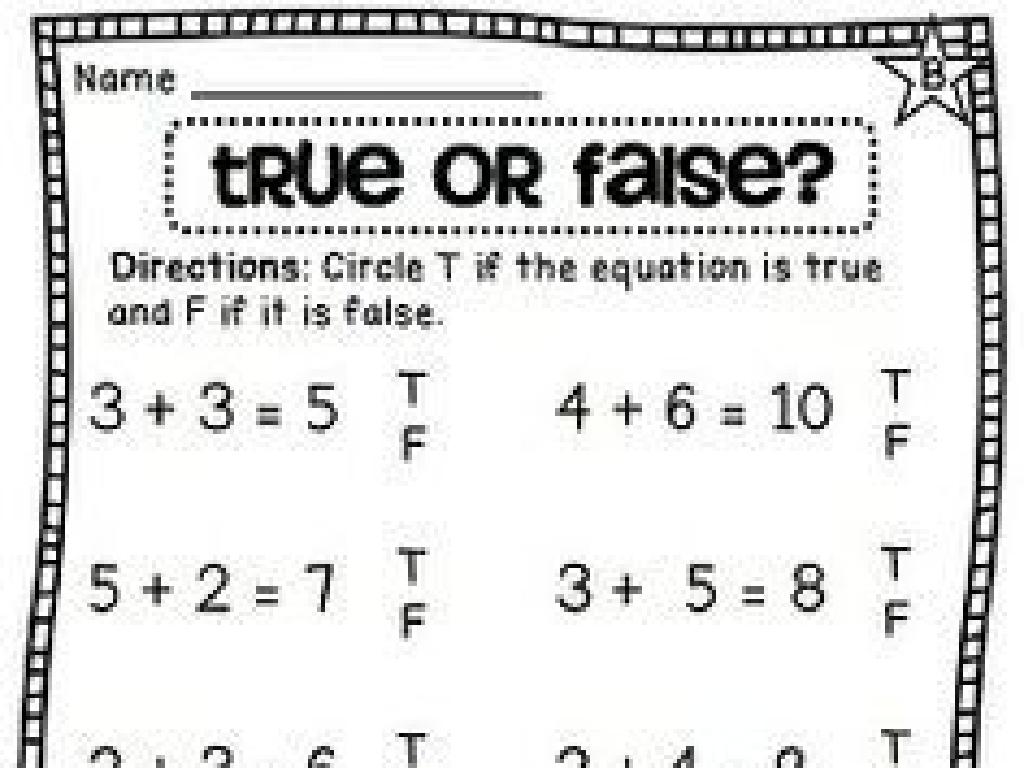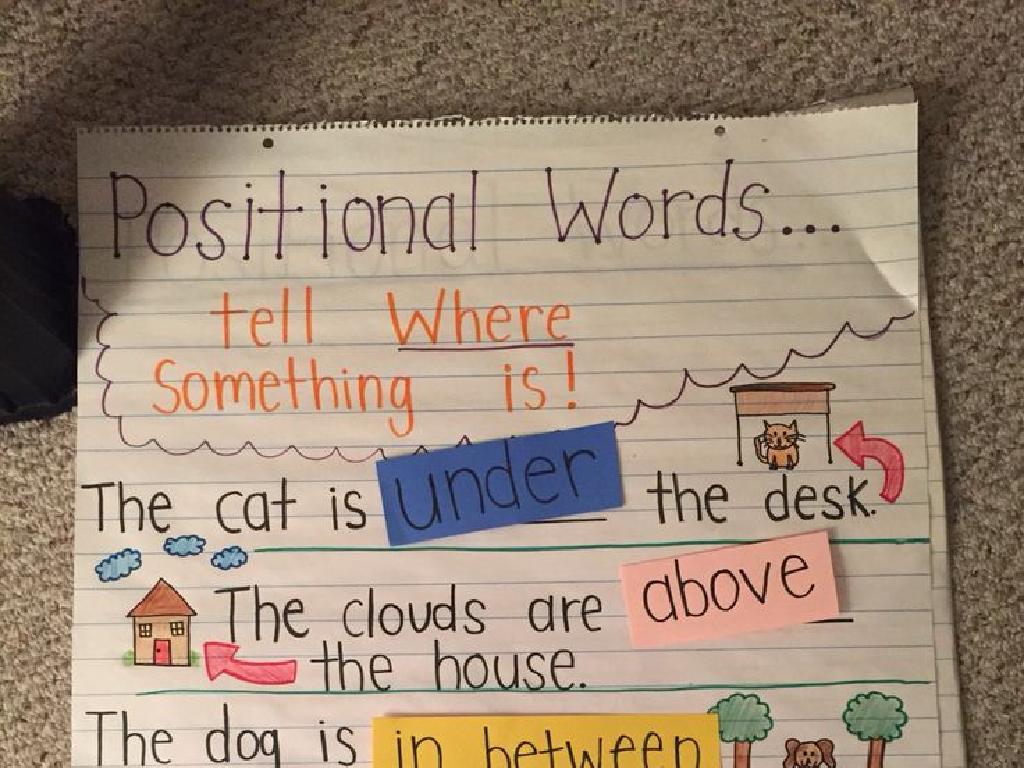Compare Decimal Numbers
Subject: Math
Grade: Fourth grade
Topic: Decimals
Please LOG IN to download the presentation. Access is available to registered users only.
View More Content
Today’s Adventure: Comparing Decimal Numbers!
– Understand decimal digit values
– Each place after the decimal represents a fraction of ten.
– Compare decimals step by step
– Line up the decimals, then compare digits from left to right.
– Decimals in daily life
– Used in money, measurements, and more.
– Practice with examples
– Example: Which is greater, 0.65 or 0.56?
|
This slide introduces the concept of comparing decimal numbers, which is a fundamental skill in mathematics and everyday life. Start by explaining the value of each digit after the decimal point, emphasizing that they represent tenths, hundredths, etc. Show students how to compare decimals by lining them up and comparing each digit. Discuss the importance of decimal numbers in practical situations like handling money or measuring ingredients. Provide examples and encourage students to practice comparing decimals with real-life scenarios to solidify their understanding.
Understanding Decimals
– Reviewing decimal basics
– Decimals as fractions of a whole
– Like pieces of a pie, decimals show parts of one
– Decimals in everyday prices
– Example: $4.50 is 4 dollars and 50 cents
– Decimals in measurements
– Example: 3.75 meters is 3 meters and 75 centimeters
|
Begin with a quick review of what decimals are, ensuring that students recall their previous lessons on the subject. Emphasize that decimals are another way to represent fractions, which helps in understanding parts of a whole. Use relatable examples such as money, where decimals are used daily to represent dollars and cents, making it tangible for the students. Also, illustrate how decimals are used in measurements, such as meters and centimeters, to give them a sense of how decimals operate in real-world situations. This will set the foundation for comparing decimal numbers in subsequent slides.
Understanding Decimal Place Values
– Review whole number place values
– Learn decimal places: tenths, hundredths, thousandths
– Just like whole numbers, each place after the decimal represents a part of a whole.
– Visualize with a place value chart
– A chart helps us see the value of each digit in its place.
– Practice comparing decimals on the chart
– Let’s use the chart to compare 0.3, 0.08, and 0.305.
|
Begin with a quick review of place values for whole numbers to ensure a solid foundation. Introduce the concept of decimals using a place value chart, emphasizing the tenths, hundredths, and thousandths places. Explain that these places represent parts of a whole, similar to how whole number place values represent increasing quantities. Use the chart to help students visualize and understand the size of decimals in relation to each other. Provide examples and encourage students to practice placing decimals on the chart to compare their values. This visual approach will help solidify their understanding of decimal place values and prepare them for comparing decimal numbers.
Comparing Decimal Numbers
– How to compare decimals
– Look at the highest place value first
– Use a place value chart
– Place each number in the chart to compare
– Example: 0.5 vs 0.65
– 0.65 is greater because 6 tenths is more than 5 tenths
|
When comparing decimal numbers, it’s important to start with the highest place value, which is the leftmost digit. A place value chart can help students visualize and align the numbers to see which is greater or smaller. For example, when comparing 0.5 and 0.65, we look at the tenths place first. Since 6 tenths is greater than 5 tenths, 0.65 is the larger number. Encourage students to practice with more examples and to explain their thinking process. This will help solidify their understanding of decimal place values and comparison.
Using the Number Line to Compare Decimals
– Place decimals on a number line
– Each point on a number line represents a decimal value.
– Compare decimals by position
– Decimals to the right are larger than those to the left.
– Classroom activity: Number Line
– Students will physically place decimals on a large number line.
|
This slide introduces the concept of using a number line to compare decimal numbers. Begin by explaining how a number line works and how each point represents a decimal value. Emphasize that as you move right on the number line, the values increase, so decimals that appear further to the right are larger. For the classroom activity, provide students with decimal numbers on paper slips and have them place these on a large number line taped to the floor or drawn on the board. This hands-on activity will help solidify their understanding of decimal placement and comparison. Possible variations of the activity could include using different sets of decimal numbers, having students work in teams, or timing the activity for a fun challenge.
Let’s Practice Comparing Decimals!
– Practice problems on decimals
– Tips: line up and compare places
– Ensure decimals are aligned; then compare digits from left to right.
– Class examples to work through
– We’ll solve examples together, step by step.
– Understand decimal comparison
|
This slide is designed for an interactive class activity focused on comparing decimal numbers. Start by providing practice problems for the students to attempt. Emphasize the importance of lining up the decimal points and comparing the digits from the highest place value down. Work through examples as a class, guiding students through the process and encouraging participation. This will help solidify their understanding of decimal comparison. For the notes, prepare several examples with varying levels of difficulty and be ready to offer additional tips, such as looking at the number of digits after the decimal point and using zeros to help compare.
Real-Life Applications of Comparing Decimals
– Importance of comparing decimals
– Decimals in money and shopping
– Comparing prices to find the best deal
– Decimals in measurements
– Using a ruler to compare lengths
– Decimals in scores and games
– Higher scores win in games
|
Understanding how to compare decimal numbers is crucial in everyday life. This slide aims to show students the practical applications of this skill. For instance, when dealing with money, students need to compare decimals to understand prices and calculate change. Measurements often require comparing decimals to determine lengths, weights, and volumes accurately. In sports or games, comparing decimal scores can determine winners or rankings. Encourage students to think of times they have used decimal comparison in their lives and discuss how it helped them make decisions. This real-world connection reinforces the importance of the concept and its relevance beyond the classroom.
Class Activity: Decimal Detective
– Become a Decimal Detective!
– Find classroom items with decimals
– Compare the decimal numbers
– Which is greater, 0.5 or 0.05? How do you know?
– Share and explain your findings
– Discuss why one decimal is larger or smaller
|
In this engaging activity, students will search the classroom for items that have decimal numbers, such as rulers, weights, or liquid measurements. They will then compare these decimal numbers to determine which are larger or smaller. Encourage students to use their knowledge of place value to make these comparisons. After the search, students will present their findings to the class, explaining how they determined which decimals were greater or less than the others. Possible variations of the activity could include comparing prices of items in a classroom store, measuring objects to the nearest tenth, or using a menu to compare food prices. This activity will help solidify their understanding of decimal place value and comparison.
Conclusion & Review: Comparing Decimals
– Recap: Why compare decimals?
Understanding decimals’ value is crucial in math.
– Review steps for comparison
Line up decimals, compare digits, use symbols.
– Engage in Q&A session
Ask questions to clear up any confusion.
– Reinforce learning with examples
|
As we wrap up today’s lesson on comparing decimal numbers, it’s important to remind students why this skill is important. It helps in understanding the value of numbers in real-world contexts like money and measurements. Review the steps: lining up the decimal points, comparing digits starting from the left, and using comparison symbols. Encourage students to ask questions during the Q&A to address any uncertainties they may have. Finish with a few examples to ensure students leave the class with a solid understanding of how to compare decimal numbers.






